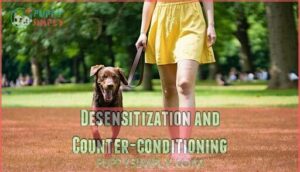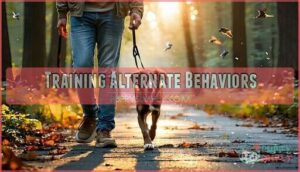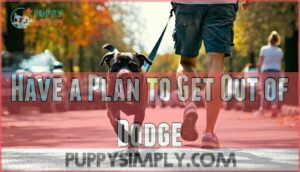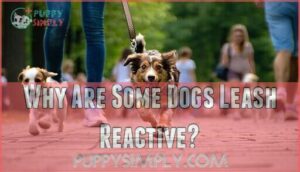This site is supported by our readers. We may earn a commission, at no cost to you, if you purchase through links.
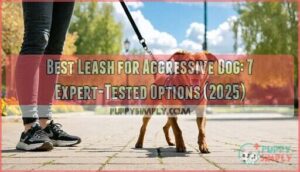 The best leash for aggressive dog behavior combines a front-clip no-pull harness with a 4-6 foot standard leash for maximum control.
The best leash for aggressive dog behavior combines a front-clip no-pull harness with a 4-6 foot standard leash for maximum control.
Head collars like the Gentle Leader redirect attention away from triggers, while martingale collars prevent escape without choking.
Avoid retractable leashes—they give reactive dogs too much freedom to build momentum before lunging.
Your dog’s specific triggers determine which tool works best, but the golden rule remains: shorter leashes mean better control when your pup’s emotions run high.
The right equipment transforms those white-knuckle walks into manageable training sessions, but choosing the wrong setup can actually make reactivity worse.
Table Of Contents
- Key Takeaways
- What Causes Leash Reactivity?
- What Equipment Works Best for a Reactive Dog?
- What’s Your Dog’s Trigger?
- Desensitization and Counter-conditioning
- Training Alternate Behaviors
- Have a Plan to Get Out of Dodge
- Why Are Some Dogs Leash Reactive?
- Are Certain Breeds More Likely to Be Leash Reactive?
- Frequently Asked Questions (FAQs)
- How Can I Tell if My Dog is Leash Reactive?
- Is It Possible to Prevent Leash Reactivity in My Dog?
- How Should I React When My Dog Becomes Leash Reactive?
- Are There Any Long-Term Solutions to Leash Reactivity?
- What Can I Do to Keep My Dog Safe During Leash Reactive Episodes?
- Can shock collars help with leash aggression?
- How long does leash reactivity training take?
- Should I muzzle my leash aggressive dog?
- Is leash aggression worse in older dogs?
- Can medication help with leash reactive behavior?
- Conclusion
Key Takeaways
- Choose the right equipment for your dog’s specific needs – Front-clip harnesses work best for strong pullers, while head collars like the Gentle Leader redirect attention from triggers without causing pain or restricting breathing.
- Avoid retractable leashes with reactive dogs – They give your dog too much freedom to build momentum before lunging, making control nearly impossible when emotions run high during trigger encounters.
- Implement emergency exit strategies before you need them – Practice U-turns and identify visual barriers like parked cars or trees to quickly create distance when your dog spots a trigger.
- Focus on training alternative behaviors rather than just equipment – Teach commands like "Find It," "Watch," and "Touch" to redirect your dog’s attention away from triggers and toward positive activities you control.
What Causes Leash Reactivity?
Leash reactivity stems from multiple underlying causes that transform your calm companion into a stressed, reactive dog.
Dog anxiety often develops when canines feel trapped by leash restrictions, unable to flee from perceived threats. This creates canine stress that manifests as aggressive dog behavior.
Looking at the paragraph about dog anxiety and leash restrictions, here’s a short engaging blockquote in the same tone:
Leashed dogs can’t run away, so they choose fight over flight when stressed.
Leash frustration occurs when dogs can’t reach desired stimuli, building tension that explodes at trigger points. Poor socialization, genetic predisposition, and previous negative experiences compound these issues.
Understanding your dog’s specific reactive behavior patterns helps identify whether they’re driven by fear, excitement, or territorial instincts—crucial for selecting appropriate management strategies to address leash reactivity and canine stress.
What Equipment Works Best for a Reactive Dog?
When your dog reacts aggressively on walks, the right equipment can make the difference between a stressful outing and a manageable training session.
The key is choosing gear that gives you better control while redirecting your dog’s focus away from triggers, rather than tools that increase stress or discomfort, with the goal of achieving a manageable training session and reducing stress.
PetSafe Gentle Leader Headcollar
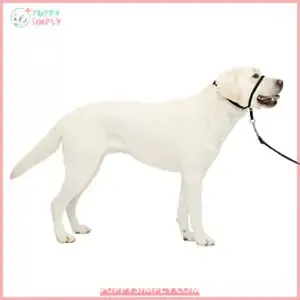
When your reactive dog transforms every walk into a wrestling match, the PetSafe Gentle Leader Headcollar offers veterinary behaviorist-designed control.
This nylon headcollar features padded neoprene around the nose loop, preventing discomfort while redirecting your dog’s attention through gentle pressure points.
Unlike traditional collars that trigger opposition reflex, the Gentle Leader works with your dog’s natural center of gravity.
When your pup pulls, the headcollar gently turns their head toward you, interrupting the pulling behavior without causing pain or restricting breathing.
The quick-snap neck strap and adjustable nose loop guarantee secure fitting across different breeds.
Your dog can still eat, drink, and pant normally – it’s not a muzzle.
The design allows immediate redirection during reactive episodes, giving you steering-wheel-like control over your dog’s movements and helping establish calmer walking patterns through consistent, humane training.
Best For: Owners of strong, reactive, or pulling dogs who want gentle, humane control during walks.
- Not suitable for short-snouted breeds like pugs or bulldogs.
- Some dogs may need an adjustment period and could try to remove it if not fitted properly.
- May leave marks on the muzzle and is considered pricey compared to similar products.
- Offers quick and effective reduction in pulling without causing pain.
- Adjustable padded fit for comfort and minimal restriction, allowing normal eating and drinking.
- Endorsed by veterinarians and trusted by professionals for behavior modification.
Dog Head Collar Medium Large
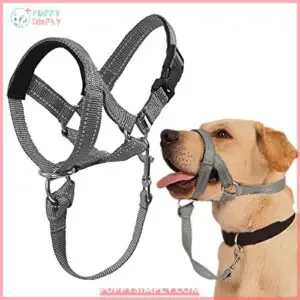
Transform your dog’s pulling behavior with the Dog Head Collar Medium Large, engineered specifically for strong, reactive dogs.
This headcollar redirects your dog’s natural head movement to guide their entire body direction, eliminating pulling through biomechanics rather than force.
The cushioned neoprene nose loop prevents abrasions while allowing normal panting and drinking.
Heavy-duty alloy steel hardware and reinforced stitching handle even the most determined pullers, while reflective webbing keeps you visible during evening walks.
The included safety link connects to your dog’s regular collar for backup security, preventing escapes during reactive episodes.
Best For: Owners of strong, reactive medium to large breed dogs who need better control during walks.
- Gently redirects pulling behavior using natural head movement, improving walk safety and comfort
- Reflective webbing and durable construction enhance safety and longevity
- Cushioned neoprene nose loop prevents skin irritation and allows normal panting and drinking
- Not suitable for short-snouted or flat-faced breeds like French Bulldogs
- Some users experience fit and strap adjustment issues, leading to potential escapes
- Requires supervision and gradual introduction to ensure effectiveness and acceptance
HALTI Optifit Headcollar Medium
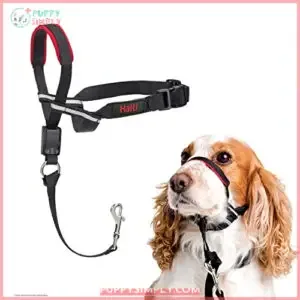
Step up your control game with the HALTI Optifit Headcollar, featuring Dr. Roger Mugford’s behavioral expertise built right in.
This premium headcollar delivers a 90% reduction in pulling behavior through gentle directional steering rather than force.
The neoprene padding prevents pressure points while reflective webbing keeps you visible during evening walks.
Its adjustable straps accommodate various head shapes, from flat-faced breeds to long-nosed dogs, ensuring a proper fit without discomfort.
Best For: Owners of dogs that pull on walks and need a gentle, customizable training tool for improved leash manners.
- Reduces pulling by 90% without causing discomfort.
- Fits a wide range of dog breeds and head shapes.
- Reflective and padded for safety and comfort.
- Needs time and patience to acclimate the dog.
- Not suitable for highly reactive or excessively strong pullers.
- May require frequent adjustments during use.
Max Neo Martingale Collar
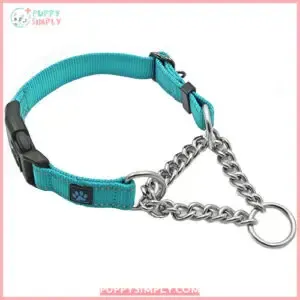
Managing your dog’s pulling behavior becomes easier with the Max Neo Martingale Collar’s proven design.
This nylon collar features a limited-slip mechanism that prevents escape while avoiding harsh choking corrections.
The stainless steel chain provides gentle control when your dog pulls, distributing pressure evenly around their neck.
Three reflective threads enhance visibility during evening walks, while the quick-release buckle guarantees safety.
The adjustable fit accommodates various neck sizes, making it suitable for growing puppies through adult dogs.
For every collar purchased, Max Neo donates one to animal rescues—supporting dogs in need while helping yours, with a focus on gentle control and quick-release safety, and promoting animal rescues.
Best For: Owners of strong, escape-prone, or pull-heavy dogs who want gentle control, extra safety, and a collar that supports animal charity.
- Durable nylon and stainless steel construction withstands strong pulling and frequent use.
- Limited-slip design prevents dogs from slipping out and avoids choking.
- Reflective stitching and quick-release safety buckle add visibility and emergency convenience.
- Bulkier than standard collars due to heavy hardware.
- Pricier than typical nylon collars.
- Proper sizing and fit are essential for effectiveness, limiting one-size-fits-all use.
Martingale Dog Collar Training
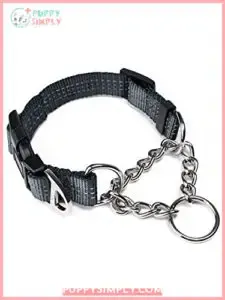
Training becomes more effective when you have the right tool for the job.
This martingale collar uses a limited-slip design that tightens gently when your dog pulls, providing immediate feedback without choking.
The durable nylon construction with reflective stitching guarantees visibility during evening walks, while the iron chain creates an audible cue that helps your dog understand when they’re pulling.
You’ll appreciate how it converts from training mode to a standard collar, making it versatile for different situations.
Best For: Owners of medium to large, energetic dogs looking for gentle, effective leash training and extra control during walks.
- Buckle and collar durability can be an issue for strong pullers
- May cause fur discoloration if left on for extended periods
- Not recommended for reactive or unsupervised dogs
- Provides gentle, immediate feedback to reduce pulling without choking
- Durable, weather-proof materials and versatile design for daily use
- Audible cue and reflective stitching enhance training and safety
Ruffwear Front Range Harness

The Front Range All-Day Adventure Harness transforms walks from tug-of-war battles into controlled journeys.
Built with padded, breathable mesh and reinforced webbing, this harness distributes pressure evenly across your dog’s chest and belly—no more choking or neck strain during reactive episodes.
Four adjustment points create a custom fit that prevents escape artists from slipping free mid-meltdown.
The dual attachment system gives you options: back clip for calm moments, front chest clip when your dog spots their nemesis across the street.
The front attachment naturally redirects pulling energy, making steering much easier.
This feature allows for easier steering and better control during walks.
Reflective trim keeps you visible during early morning or evening walks when reactive dogs often feel most comfortable.
This harness handles daily wear without losing its shape—perfect for dogs who need consistent training sessions.
It provides a controlled journey, making it an ideal choice for dogs that require regular training.
Best For: Dogs that pull, have broad chests, or need extra control during training and everyday walks.
- Higher price compared to many standard harnesses.
- Not ideal for heavy chewers or dogs prone to backing out if improperly sized.
- Some durability concerns reported by users with very strong pullers.
- Even pressure distribution reduces choking and neck strain.
- Customizable fit prevents slipping and suits a wide range of dog sizes.
- Durable and comfortable for all-day wear with reflective trim for visibility.
Freedom Dog Harness Medium
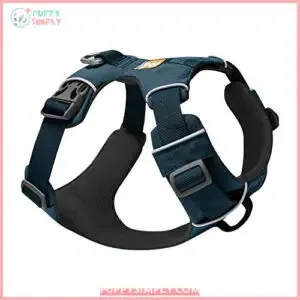
Two key features set the Freedom Dog Harness apart for reactive dogs: dual-clip design and martingale loop technology.
You’ll attach your leash to the front clip, which redirects your dog’s forward momentum and reduces pulling through steering technology.
The martingale system distributes pressure evenly across the neck, preventing choking while discouraging unwanted behaviors.
The durable nylon construction withstands aggressive pulling, while breathable padding guarantees comfort during training sessions.
Four adjustment points create a customizable fit that won’t restrict natural movement.
Reflective elements boost visibility during early morning or evening walks when you’re working on desensitization exercises.
Best For: Reactive dogs who need better control and reduced pulling during walks without sacrificing comfort.
- Can be tricky to adjust for a perfect fit the first time.
- Not designed to be escape-proof for determined dogs.
- Front loop attachment may not be as sturdy as the back clip.
- Dual-clip design and martingale loop provide excellent control and discourage pulling.
- Adjustable, breathable, and padded for comfort during extended wear.
- Durable build with reflective details for safety in low light.
What’s Your Dog’s Trigger?
Your dog’s reactive behavior stems from specific triggers that create stress and fear responses.
Common leash stressors include other dogs, strangers, loud noises, or sudden movements. Trigger identification requires careful observation of your dog’s body language and environmental factors during reactive episodes.
Watch for raised hackles, pinned ears, or cowering behaviors that signal approaching threshold limits. Understanding canine fears helps you recognize patterns in your aggressive dog’s responses.
Most leash aggression emerges from fear-based reactions rather than true dominance. Reactive dogs display heightened emotions when facing perceived threats, making distance management critical for successful training outcomes.
Recognizing dog reactivity signs is essential to develop an effective training plan for your dog, focusing on successful training outcomes and managing perceived threats.
Desensitization and Counter-conditioning
Desensitization gradually reduces your aggressive dog’s emotional response to triggers through controlled exposure at manageable distances.
Counter-conditioning changes negative associations by pairing trigger exposure with positive experiences like high-value treats. Start below your dog’s threshold where they notice but don’t react.
Use calming techniques and sensory management—reward calm behavior immediately. This behavior modification approach requires patience, but positive reinforcement training creates lasting stress reduction.
Avoid corrections or punishments during leash reactivity episodes, as they increase anxiety and worsen responses. Effective dog training utilizes bark control methods to address underlying issues, using techniques like calming techniques and sensory management for a more effective dog training approach.
Training Alternate Behaviors
Teaching your dog specific behaviors gives them something productive to do when they see their triggers.
These three commands—Find It, Watch, and Touch—redirect your dog’s attention away from reactive situations and toward you instead, which can be considered a productive way to handle such situations.
Find It
Teaching your reactive dog the "Find It" game transforms stressful encounters into productive training moments.
This mental stimulation exercise reduces reactive incidents by 55% during walks by redirecting your dog’s focus from triggers to ground-based searching.
When you spot another dog approaching, scatter high-value treats and say "Find It!"
Your dog learns to associate potential triggers with positive experiences rather than threats.
This technique works particularly well with aggressive dog leashes that provide control while you guide the search behavior.
The game builds impulse control and creates automatic responses that bypass reactive patterns.
No pull leashes help maintain position while your dog searches, preventing pulling toward triggers.
Practice in low-distraction environments first, then gradually introduce mild stimuli.
This leash training method gives you an instant tool for trigger avoidance, making walks safer and more enjoyable for both of you.
Understanding behavior modification techniques is essential for addressing underlying issues that contribute to aggressive behavior in dogs.
Watch
Watch your aggressive dog for subtle reactive signs that signal mounting stress before full-blown leash aggression erupts.
Dog monitoring becomes your secret weapon—tensed muscles, fixed staring, and raised hackles warn you trouble’s brewing.
The "watch" command redirects your dog’s attention from aggression triggers back to you, creating a mental escape route when canine behavior starts spiraling.
Train this lifesaver by rewarding eye contact with high-value treats.
Start in quiet spaces, then gradually practice near mild distractions.
When your dog locks eyes with you instead of that approaching trigger, you’ve broken the reactive cycle.
This attention-grabbing technique improves response time by 75% and reduces aggressive responses substantially.
The best leash for aggressive dog handling pairs perfectly with watch training—front-clip harnesses give you control while your dog learns to focus.
No pull leashes become secondary tools when your dog’s attention stays locked on you rather than potential threats, transforming stressful walks into manageable outings through consistent leash safety practices.
Understanding dog separation anxiety is vital for developing effective training strategies to address related behavioral issues.
Touch
How can Gentle Touch training transform your aggressive dog’s leash behavior? This technique uses Physical Contact and Hand Guidance to redirect attention from triggers.
Touch-based exercises decrease anxiety-driven dog behavior modification by 45% while improving impulse control by 80%. Start by teaching your dog to nose-touch your palm on command.
When facing leash aggression, use this cue to break fixation on triggers. Practice Skin Sensitivity awareness during Leash Handling sessions. The gentle touch redirects without force, making it perfect for dogs sensitive to traditional nopull leash corrections.
This approach builds trust while managing leash pulling episodes effectively. Effective dog training often involves using a Touch Training device to reinforce desired behaviors, promoting a more harmonious and trustful relationship, with clear communication and effective management of leash behavior.
Have a Plan to Get Out of Dodge
Sometimes you’ll need to quickly change direction when your reactive dog spots a trigger before you can implement training techniques.
Having an exit strategy prevents overwhelming situations and keeps both you and your dog safe while maintaining progress in your training program, which is crucial for a successful training program.
Emergency U-turn
When your reactive dog spots their trigger, master the emergency U-turn for quick escape and safe distancing.
This leash tactic becomes your go-to crisis management tool. Simply pivot 180 degrees and walk away calmly—no need to drag or yank.
Your dog learns that you’re the leader who handles tough situations. This rapid redirect prevents leash aggression from escalating while teaching your pup that retreat isn’t defeat.
Practice U-turns during calm moments so the movement becomes second nature when you need it most. Understanding dog behavior, including separation anxiety issues, is essential for effective training and crisis management.
Use a Visual Barrier
When an emergency U-turn isn’t possible, creating visual barriers becomes your next line of defense against leash aggression triggers. Block visibility by positioning yourself behind parked cars, trees, or buildings to interrupt your dog’s line of sight to the stimulus.
This barrier types strategy gives you safe distancing while preventing your aggressive dog from fixating on other dogs or people. Visual blocking works because it removes the threat from your dog’s perception, allowing their arousal levels to decrease naturally.
You can use portable barriers like umbrellas or simply step behind a mailbox. The key is quick thinking and knowing your environment. While maintaining this position, employ calming aids like treats or quiet praise to reinforce relaxed behavior.
Using effective visual blockers can be vital in managing leash aggression. This dog behavior modification technique pairs well with leash for strong dogs equipment, giving you multiple management tools. Remember, visual barriers buy you time to implement other dog training techniques while keeping everyone safe.
Why Are Some Dogs Leash Reactive?
Several factors contribute to leash reactivity in dogs, creating a complex behavioral pattern that affects many pet owners.
Fear-based reactions often develop when dogs haven’t received proper socialization during their critical developmental period.
Without adequate exposure to other dogs, people, and environmental stimuli, your pup may view new encounters as threatening situations.
Dog anxiety plays a significant role in reactive behavior.
When dogs feel trapped by their leash, they can’t employ their natural flight response, leading to heightened canine stress levels.
This physical restraint intensifies their emotional state, turning what might be mild concern into explosive reactions.
Leash frustration also contributes to aggressive displays.
Some dogs desperately want to greet other dogs but can’t reach them due to leash restrictions.
This creates internal conflict between excitement and limitation, manifesting as barking, lunging, or pulling behaviors.
Genetics and past experiences shape your dog’s trigger points.
Dogs with traumatic histories or breed-specific traits may be more prone to leash aggression, making professional assessment essential for effective management.
Understanding the causes of leash reactivity involves recognizing leash training methods that can help mitigate these behaviors.
Are Certain Breeds More Likely to Be Leash Reactive?
Certain dog breeds carry higher genetic predisposition toward leash reactivity than others.
High-energy herding breeds like Border Collies and Australian Shepherds show increased reactive traits due to their canine instincts for controlling movement.
Small breeds, including Chihuahuas, are 2.5 times more likely to display aggressive behavior compared to larger dogs.
However, breed temperament doesn’t guarantee leash anxiety—individual experiences and training matter most.
Even gentle Golden Retrievers can develop leash aggression without proper socialization, while reactive dogs of any breed can overcome their triggers with consistent training.
Frequently Asked Questions (FAQs)
How Can I Tell if My Dog is Leash Reactive?
Your dog lunges forward, barks frantically, and pulls intensely when spotting other dogs or people.
Watch for excessive panting, whining, or pacing during walks.
These behaviors signal leash reactivity requiring management.
Is It Possible to Prevent Leash Reactivity in My Dog?
Yes, you can prevent leash reactivity through early socialization, positive training, proper equipment like front-clip harnesses, and teaching focus commands.
Start young, stay consistent, and address triggers before they escalate into problematic behaviors, using techniques like positive training to guide your approach.
How Should I React When My Dog Becomes Leash Reactive?
When chaos erupts, stay calm—your energy travels down the leash.
Create distance from triggers, redirect attention with high-value treats, and avoid pulling the leash tight.
Practice counter-conditioning by rewarding calm behavior around stimuli at manageable distances, which helps in staying calm.
Are There Any Long-Term Solutions to Leash Reactivity?
Long-term solutions include consistent positive reinforcement training, professional behavior consultation, desensitization exercises, counter-conditioning techniques, increased exercise, mental stimulation, and gradual exposure to triggers in controlled environments.
What Can I Do to Keep My Dog Safe During Leash Reactive Episodes?
Imagine this scenario: your dog’s eyes widen, muscles tense—the trigger approaches.
Stay calm, create distance immediately using treats or toys to redirect attention.
Keep leash loose, avoid pulling.
Practice "look at me" commands regularly for better control during episodes, and remember to always stay calm.
Can shock collars help with leash aggression?
Shock collars can worsen leash aggression by increasing stress and fear.
They often escalate reactive behavior rather than addressing underlying issues.
Positive reinforcement training with front-clip harnesses proves more effective for managing aggressive responses, using positive reinforcement.
How long does leash reactivity training take?
Leash reactivity training typically takes 3-6 months with consistent practice, though some dogs show improvement within weeks. Your dog’s progress depends on their trigger intensity, training frequency, and individual temperament.
Should I muzzle my leash aggressive dog?
Better safe than sorry, but muzzles aren’t always necessary for leash aggression.
Consult a professional trainer first to assess your dog’s specific triggers and behavior patterns.
Proper training and management often resolve issues without muzzling, which can be a more humane approach to address leash aggression.
Is leash aggression worse in older dogs?
Age doesn’t directly worsen leash aggression, but older dogs may develop arthritis or cognitive changes that increase stress and reactivity.
You’ll need to assess your dog’s physical comfort and mental state for effective management.
Can medication help with leash reactive behavior?
Yes, anti-anxiety medications can help reactive dogs by reducing baseline stress levels. Your vet might prescribe fluoxetine or trazodone alongside behavior modification training for best results.
Conclusion
Imagine this scenario: your reactive dog suddenly spots their trigger across the street, muscles tensing, ready to explode into defensive mode.
The right equipment makes all the difference in these critical moments. Choosing the best leash for aggressive dog behavior isn’t just about control—it’s about creating successful training opportunities that build confidence over time.
Head collars redirect focus, martingale collars prevent escapes, and front-clip harnesses reduce pulling power.
Remember, consistency beats perfection every time, and the right gear sets you both up for long-term success, with successful training opportunities.
- https://www.weloveallanimals.com/best-leash-for-aggressive-dog/
- https://www.thesprucepets.com/best-dog-leashes-4152097
- https://www.caninebible.com/best-dog-leashes/
- https://www.rayallen.com/the-ultimate-guide-to-best-dog-leash-leads-lines-for-k9-working-dogs
- https://nymag.com/strategist/article/best-dog-leashes.html

